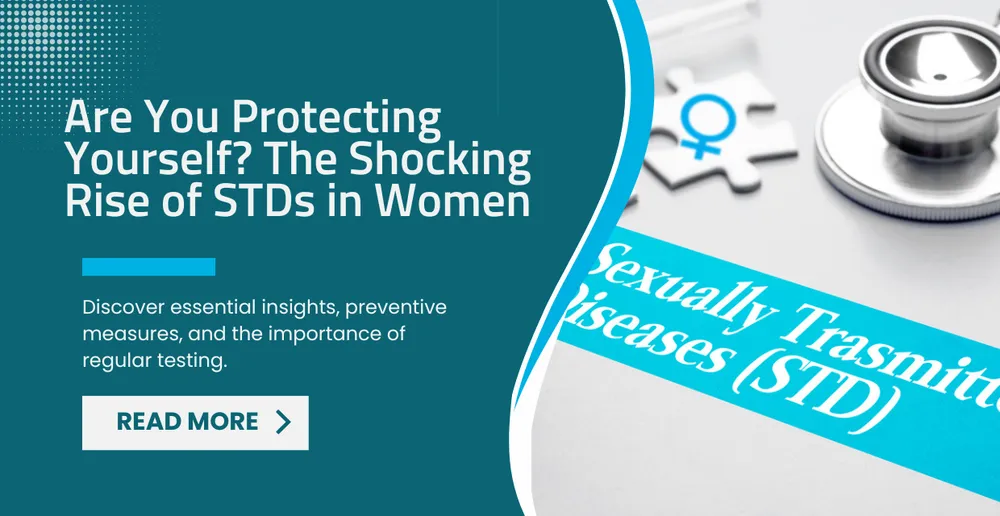Navigating Menopause: Expert Tips for a Smooth Transition
As women age, their bodies undergo a natural transition known as menopause. While this is a natural process, it can be an overwhelming experience for many women...

It's a topic that many people feel uncomfortable talking about, but it's one that can't be ignored. The shocking rise of sexually transmitted diseases (STDs) in women is reaching epidemic proportions. Despite medicine and education advancing to greater heights, the number of cases has been steadily increasing year after year.
In this article, we'll take a look at the alarming statistics surrounding STDs in women, explore why they are on the rise, and discuss what steps you can take to protect yourself. It's time to face the facts and take action to prevent this growing health crisis from becoming even more widespread.
In India, around 6% of the adult population is diagnosed with one or more STI/RTI. There are several factors that contribute to the high rates of STDs in women:
Lack of awareness: Many women may not know enough about STDs, including how they are transmitted and the importance of safe sex practices. This can lead to risky behaviors, such as having unprotected sex, which can increase the risk of contracting an STD.
Stigma: There is still a lot of shame and stigma surrounding STDs, which can prevent women from seeking medical care or discussing their sexual health with their partners. This can lead to untreated infections and the spread of STDs.
Multiple sexual partners: Women who have multiple sexual partners are at a higher risk of contracting an STD. This is because each sexual encounter increases the likelihood of coming into contact with an infected partner.
Unprotected sex: Not using condoms or other forms of protection during sexual activity can increase the risk of contracting an STD.
Substance abuse: Substance abuse, such as alcohol or drugs, can impair judgement and lead to risky sexual behaviors, which can increase the risk of contracting an STD.
There are many different types of bacteria and viruses that can cause STDs. Some of the most common causes include unprotected vaginal, anal, or oral sex with an infected partner, as well as sharing needles or other drug paraphernalia with someone who is infected.
People who have multiple sexual partners or engage in high-risk sexual behaviors, such as not using condoms or having sex while under the influence of drugs or alcohol, are at a higher risk of contracting STDs.
Some STDs can also be passed from a pregnant woman to her baby during childbirth or breastfeeding. This is known as perinatal transmission and can result in serious health problems for the baby.
It's important to note that anyone can get an STD, regardless of age, gender, or sexual orientation. However, young people, men who have sex with men, and people who live in poverty or have limited access to healthcare are at a higher risk of contracting these infections.

The structure of the female reproductive system makes it easier for bacteria and viruses to enter and infect the body. The vagina, cervix, and uterus are all exposed to potential infection during sexual activity, while the male reproductive system has a longer distance to travel for bacteria or viruses to reach the bladder or other organs.
Also, women often experience more micro-tears or abrasions in the vaginal lining during sexual activity, which can make it easier for STDs to enter the bloodstream.
Social factors such as gender-based violence and lack of access to healthcare can also increase women's risk of contracting an STD. Women who experience sexual violence or have multiple sexual partners may be at higher risk for STDs.
Finally, some STDs such as HPV can lead to cervical cancer in women, making regular screenings and testing even more important for women's health.
Some of the most common STDs include chlamydia, gonorrhea, herpes, syphilis, and HIV. If left untreated, these infections can lead to a range of health risks and complications.
For example, untreated chlamydia and gonorrhea can cause pelvic inflammatory disease (PID), which can lead to infertility, chronic pelvic pain, and ectopic pregnancy.
Herpes can cause painful genital sores, while syphilis can lead to organ damage and neurological problems if left untreated. HIV, the virus that causes AIDS, attacks the immune system and can eventually lead to life-threatening infections and illnesses.
In addition to these physical health risks, STDs can also have emotional and psychological consequences. The stigma associated with these infections can lead to feelings of shame, guilt, and isolation. People with STDs may also struggle with relationship and intimacy issues, as well as discrimination and social rejection.
The good news is that many STDs are treatable with antibiotics or antiviral medication. Early detection and treatment are key to preventing long-term health complications and reducing the spread of these infections to others.

One of the most important steps you can take is to educate yourself and others about the risks of STDs and how they can be transmitted. This includes learning about the different types of STDs, their symptoms, and how they can be prevented.
Here are some other ways you can protect yourself from getting an STD:
Practice safe sex: This means using condoms consistently and correctly every time you have sex, whether it's vaginal, anal, or oral.
Get tested regularly: It's important to get tested for STDs regularly, even if you don't have any symptoms. This can help you detect and treat infections early on, before they can cause serious health problems.
Limit your number of sexual partners: The more sexual partners you have, the greater your risk of contracting an STD.
Avoid sharing needles: If you use drugs, don't share needles or other drug paraphernalia with others, as this can increase your risk of contracting HIV and other STDs.
Talk openly and honestly with your partners: It's important to have open and honest conversations with your sexual partners about your sexual health, any concerns you may have, and your expectations for safe sex.
You can significantly reduce your risk of getting an STD and protect your sexual health by following these steps. Education and awareness can act as important means of preventing the spread of STDs, so make sure to spread the word and educate others about the importance of safe sex and regular STD testing.
Choose LifeCare Hospitals for comprehensive treatment of Sexually transmitted Diseases (STDs). With expert care from our experienced gynecologists and urologists, committed to providing compassionate, confidential care for all of our patients. Whether you're in need of routine testing, treatment for an active infection, or ongoing management of a chronic condition, we're here to help.
With state-of-the-art facilities and advanced diagnostic tools, we can quickly and accurately diagnose and treat a wide range of STDs, including chlamydia, gonorrhoea, and syphilis. We also offer counseling and education to help you prevent future infections and maintain your sexual health.
Don't wait to take charge of your sexual health. Contact Lifecare Hospitals today to schedule an appointment with one of our experts and get the care you need to stay healthy and happy.
Partager cet article